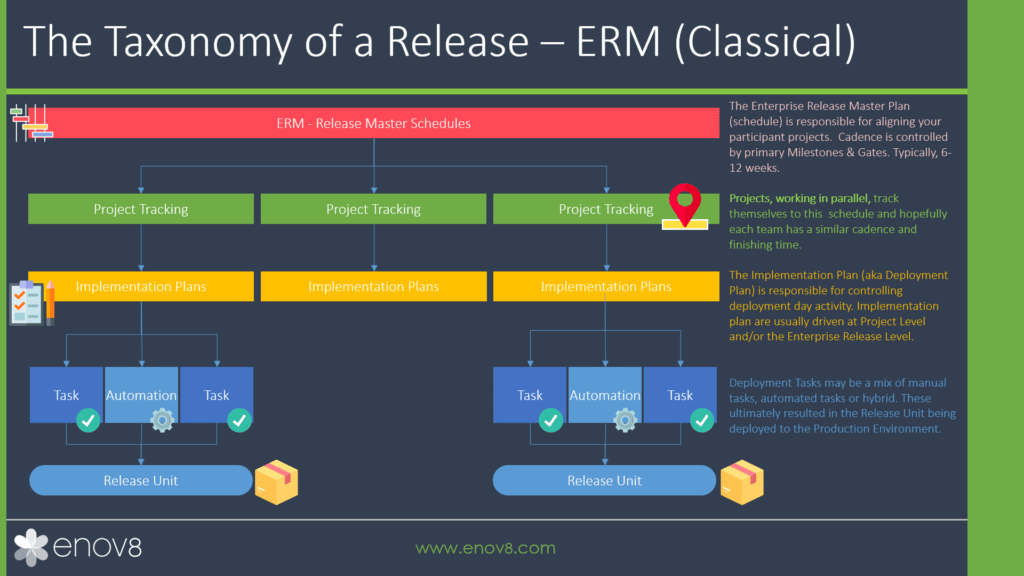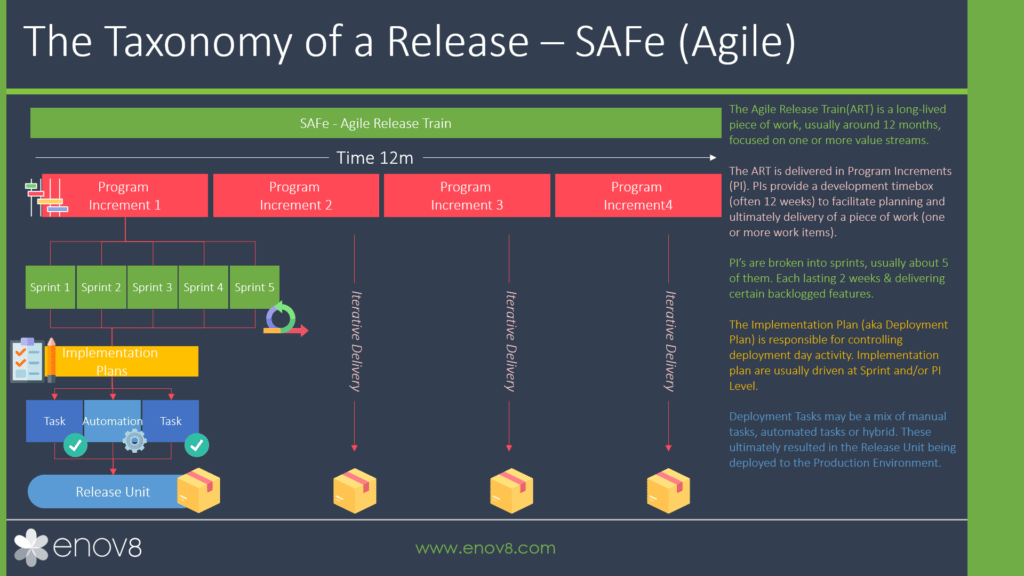
In the world of enterprise software, release management is a crucial process that ensures the successful planning, execution, and monitoring of software releases. As the name suggests, release managers are responsible for coordinating various stakeholders, including developers, testers, operations staff, and end–users, to achieve the desired business objectives. This discipline is a vital component of software development and IT operations, providing a comprehensive overview of the software release process.
In this post we break it down from the perspective of the two main methods i.e. classical ERM (enterprise release management), and SAFe (Scaled Agile Framework).
Why Release Management?
The release management process is essential for ensuring a frictionless systems development life cycle, agile development, and ensuring the software is released in a controlled and safe manner. Without a formalized release management process, it’s easy to introduce new bugs into the system or to deploy applications before they are ready.
The Two Release Management Methods
In the modern world, two Release Management methods dominate:
- Classical, Enterprise Release Management (ERM)
- Iterative Release Management, like Scaled Agile (SAFe)

The Key Stages of Release Management
Independent of which you prefer we can “safely” say a well-defined release management process includes the following key stages.
1. Identifying the Value Stream
Before any planning or execution begins, release management should start with a clear understanding of the organization’s value streams.
A value stream represents the complete set of activities required to deliver value to the customer—from initial concept through delivery, support, and realization of benefits. Mapping these streams helps teams visualize how ideas move through development and where bottlenecks or inefficiencies occur.
By defining value streams, organizations align releases around what truly drives customer value rather than internal structures or silos.
2. Scoping
Once the value stream is understood, the next step is scoping—determining exactly what work needs to be done to achieve defined objectives. This involves clarifying business goals, identifying constraints, and setting measurable success criteria. Effective scoping ensures the release delivers meaningful outcomes while staying within available time and resource limits.
3. Project or Team Onboarding
After defining the scope, it’s essential to identify the teams and roles responsible for delivering each component of the release. This stage includes onboarding new teams or contributors, clarifying ownership, and aligning expectations across departments. Proper onboarding promotes collaboration and accountability, reducing friction later in the process.
4. Planning
Planning defines what will be delivered and when. In modern enterprises, release management planning often follows agile frameworks — using quarterly program increments to set high-level direction and fortnightly sprints to deliver incremental progress.
The goal is to balance predictability and adaptability, ensuring releases align with business priorities while staying flexible enough to respond to change.
5. Tracking
Tracking provides ongoing visibility into release progress and performance. Teams typically monitor project milestones, sprint goals, and quality or compliance gates. This stage may also include managing change requests, monitoring incidents, and maintaining audit trails. Consistent tracking ensures stakeholders stay informed and issues are identified early before they impact delivery.
6. Implementation Planning
Before deployment begins, teams need a clear and well-rehearsed implementation plan. This includes identifying dependencies, scheduling environments, validating rollback procedures, and conducting mock deployments. Thorough preparation reduces the risk of surprises during go-live and helps teams react quickly if issues arise.
7. Implementation Orchestration
Execution is where release plans become reality. Implementation orchestration often involves automation to coordinate deployment, validation, and rollback steps across systems. Using release automation tools minimizes manual effort, reduces human error, and accelerates delivery speed—all while maintaining control and compliance.
8. Post-Implementation Reviews
After each release, teams should conduct structured reviews to evaluate outcomes, identify lessons learned, and refine future processes. This includes assessing deployment success, user feedback, and operational metrics. Continuous reflection helps improve cadence and quality over time.

Release management is ultimately a balancing act—keeping customers satisfied, prioritizing business needs, managing dependencies, and coordinating teams of varying maturity levels. Organizations that invest time in managing and reflecting on this process continually improve both the speed and reliability of their software delivery.
What Is Release Lifecycle Management?
Release Management and Release Lifecycle Management (RLM) are closely intertwined yet distinct concepts in software delivery. Release Management concentrates on the strategic planning, coordination, and oversight of software releases into production environments. It involves activities such as release planning, risk management, communication, and deployment coordination, all aimed at ensuring that authorized and thoroughly tested changes are seamlessly deployed with minimal disruption to services.
In contrast, RLM provides a holistic framework that encompasses the entire lifecycle of managing software releases. It extends beyond the confines of Release Management to include the development, testing, monitoring, and evaluation of releases, integrating various processes into a cohesive and comprehensive approach.
While Release Management operates within the broader context of RLM, they share an inherent interdependency. Release Management activities are executed sequentially within the framework of RLM, contributing to its overall success.
For instance, release planning and coordination activities are pivotal components of RLM’s planning phase, while deployment coordination aligns with the deployment phase. Effective Release Management practices are essential for the smooth execution of RLM, ensuring that releases are meticulously planned, coordinated, and executed in alignment with overarching objectives and processes.
Ultimately, the synergy between Release Management and RLM facilitates efficient and reliable software delivery, driving value for organizations and stakeholders alike.
What is the Release Management Workflow?
The overall approach to release management generally falls into two main camps:
- The Classical Enterprise Release Management (ERM) model
- The Iterative Scaled Agile Framework (SAFe) model
Both share many core principles (planning, coordination, and continuous improvement) but differ in how they structure and deliver work. Let’s look at each in turn.
Enterprise Release Management (ERM)
1. Define the Scope of the Release
Every release begins with clear goals. Define the business objectives, target delivery dates, and the overall purpose of the release. This ensures alignment between teams and business stakeholders.
2. Define the Release Type
Classify the release based on its impact and contents:
- Major Release: Introduces significant new functionality or changes with high business impact.
- Minor Release: Contains smaller enhancements or fixes, typically lower risk and less business-critical.
3. Create a Release Master Plan
Develop a master plan that outlines key milestones, dependencies, and dates. Typical milestones include:
- Enterprise Release Start Date (derived from the Agile Release Train)
- Enterprise Release End Date
To manage cadence and visibility, the plan should also include important release milestones or gates, such as:
- Change Management approval
- End of System Integration Testing (SIT)
- Compliance or audit approval
4. Onboard Contributing Projects
Identify and register all “child” projects contributing to the release. Clarify their deliverables and ensure they align with the master plan.
5. Map Project Plans to the Release Plan
Integrate individual project schedules into the overarching release plan to maintain synchronization and highlight interdependencies.
6. Track Projects
Use standard project management practices to monitor progress against the master plan. Maintain a consistent cadence across all teams.
Tip: If a project begins to lag significantly, consider decoupling it from the release to avoid blocking others.
7. Implementation Planning
Implementation planning means defining and sequencing all deployment activities. Conduct dry runs or simulations—ideally in a staging environment—to reduce go-live risk.
8. Implementation and Deployment Management
Execute the deployment. Depending on organizational maturity, this may be a manual process or part of an automated continuous delivery pipeline.
9. Post-Implementation Review
After the release, lead a retrospective to assess what worked and what didn’t. Analyze both the overall release and the performance of contributing projects. Use findings to refine and improve future cycles.

Scaled Agile Framework (SAFe)
1. Define the Value Stream
Start by identifying your value streams—the sequences of activities that deliver value to the customer.
- Operational value streams deliver products or services to end users.
- Development value streams create the systems and capabilities that support operational streams.
Understanding these streams ensures the release process aligns with end-to-end business value. You’ll need this clarity before creating your Agile Release Train (ART).
2. Build the Agile Release Train (ART)
The Agile Release Train is SAFe’s primary mechanism for delivering value. It’s a long-lived “team of teams,” typically 50–150 people, aligned to a shared vision and roadmap.
Key milestones:
- ART Planned Start Date
- ART Planned End Date
The ART plans, commits, and executes together, maintaining a steady flow of feature delivery tied to customer outcomes.
3. Plan the Program Increments (PI)
Program Increments represent timeboxed development periods (often one quarter or 12 weeks). Each PI includes multiple sprints and provides structure for synchronized planning and delivery.
Key milestones:
- PI Planned Start Date
- PI Planned End Date
Teams refine the program backlog, break features into user stories, and identify risks collaboratively. PI planning sessions are typically held in person to encourage communication and alignment.
4. Plan Sprint Iterations
Within each PI, work is divided into sprint iterations—short timeboxes (typically two weeks) where teams deliver incremental value.
Key milestones:
- Sprint Planned Start Date
- Sprint Planned End Date
Teams determine their sprint commitments based on capacity and summarize them as iteration goals. A typical PI consists of five sequential sprints.
5. Execute Sprint Iterations
Teams execute their planned work, tracking progress through daily stand-ups. These quick meetings ensure coordination, maintain cadence, and surface any blockers.
6. Review Sprint Iterations
At the end of each sprint, teams demonstrate completed features to stakeholders and gather feedback. This promotes transparency and ensures the product evolves in line with business needs.
7. Implementation and Deployment Management
Releases in SAFe can occur incrementally at the end of each sprint or collectively at the end of a PI. Deployment may be manual, automated, or part of a continuous delivery flow depending on maturity.
8. Sprint Iteration Retrospective
At the close of each sprint, teams hold retrospectives to discuss what went well and what could improve. Similar reviews can also occur at the end of each PI or even ART cycle to ensure continual process refinement.
Both ERM and SAFe frameworks emphasize structure, visibility, and continuous improvement—but differ in cadence and delivery model. Whether your organization leans toward traditional governance or agile flow, the goal remains the same: to coordinate change efficiently while delivering maximum business value with minimal disruption.
A Side-by-Side Comparison of ERM versus Scaled Agile
Confused? Maybe a diagram will help.
Below we provide the key components / taxonomy of Releases, from the perspective of Enterprise Release Management & then Scaled Agile. Note: In reality it is not necessarily one or the other. Organizations, and divisions within, will probably have a mix of both.


What is a Release Manager?
Classic, ERM Definition
The release management process is typically overseen by a release manager, who is responsible for coordinating all aspects of the release. In large organizations, the role of the release manager may be divided into multiple positions, focussing on different business units or value streams.
A release manager is responsible for coordinating all aspects of a software release. This includes planning the release, coordinating development and testing activities, deploying the software to production, and monitoring the performance of the software in production.
In the world of Scaled Agile, an alternative title would be Release Train Engineer (RTE), refer below.
SAFe, Release Train Engineer Definition
The Release Train Engineer (RTE) is a servant leader and operates as a full-time ‘Chief Scrum Master’ of the train. The Release Train Engineer (RTE) tracks the Features, Work-Items, and release dates.
The RTE conducts the Program Increment (PI) planning events for each ART. The RTE is also responsible for ensuring the required stakeholders attend the PI Planning Event* and that all the logistics for the successful completion of the event are in place.
(*The Program Increment (PI) Planning event is a cadence-based, face-to-face event that serves as the heartbeat of the Agile Release Train (ART), intending to align all the teams on the ART to a shared mission and Vision.)
The RTE needs to have the PI Planning, Iterations, and System Demo dates set so that stakeholders may get a complete picture of the project’s progress.
Note: It is worth noting that several ARTs can contribute to a Value Stream.

Key Release Management Roles & Responsibilities
The Release Management Roles and Responsibilities vary depending on the overarching Release Management Process. That is whether it is based on Enterprise Release Management (ERM) philosophies or more “Scaled” Agile Release Management Philosophies. Lets overview both.
ERM / Classical Definition of Roles & Responsibilities
The key ERM roles and main responsibilities at the release level are:
- The Release Manager: The main objective of an Enterprise Release Manager (ERM) is to safeguard and manage the passage of releases through the build, test, and production environments. They are guardians of the Release Management Process and the Release Plan. The ERM ensures that there is a proper structure in place to enable the business to expand successfully. Note: In large organizations, the Release Manager may offload certain release management tasks to a Release Coordinator.
- The Project Manager: In the broadest sense, “Project Managers” (PMs) are responsible for planning, organizing, and directing the completion of specific projects for an organization. In the case of ERM, they are responsible for ensuring the project is aligned on time & delivers to Milestones & Gates.
- The Project Team: The “Project Team” is in charge of delivering and maintaining the work produced.
- Implementation Manager: The Implementation Manager is responsible for defining the activities/steps for a successful Production Day implementation & change.
- Deployment Engineers: A “Software Deployment Engineer” is responsible for the deployment of software releases into production. They work with the Release Manager to ensure that deployments/releases are properly planned, tested, and executed.
SAFe / Release Train Definition of Roles & Responsibilities
The key SAFe roles and main responsibilities at the release level are:
- The Product Manager: The “Product Manager” is in charge of feature prioritization and ensuring that they are well-described and understood.
- The Release Train Engineer: The “Release Train Engineer” is in charge of ensuring that the agile release train (the team of agile teams) works together effectively and follows the procedures. Note: In SAFe, one could fairly say they are the guardians of the Release Management Process.
- The System Architect: The “System Architect” is in charge of establishing and communicating the architectural vision across the agile release train, ensuring that the finished product is appropriate.
- The Product Owner: The “Product Owner” is in charge of prioritizing stories and ensuring that they are well-described and understood.
- The Scrum Master: The “Scrum Master” is in charge of ensuring that the team performs well and follows the process.
- The Agile Team: The “Agile Team” is in charge of delivering and maintaining the work produced.

What are the benefits of Release Management?
Effective Release management is a critical part of any software development project. By following a formalized release management process, and controlling release activities (and other IT operations), you can ensure that your software is released on time, with fewer defects, and that it meets the needs of your users.
Here are some other key benefits.
1. Strategy & Work Alignment
Release Management enables connecting the organization’s top-level objectives with the people responsible for achieving them. This alignment helps to create numerous effects like boosting cross-team coordination, fostering transparency, enabling faster response times, agile development, and many more.
2. Improved Capacity Management
Release Management provides us with greater visualization across the contributing teams, systems, and flexibility to rebalance regularly. Thus minimizing the disturbance to organizational flow.
3. Holistic Planning
Successful releases require different people from different teams and departments to work together i.e., row in the same direction. The function of Release Management supports this through regular planning events which bring cross-functional teams together and builds plans that highlight potential dependencies, deliver against corporate goals, and identify the risks.
4. Enterprise-wide visibility
Visibility doesn’t only come from planning. Release Management enables transparency across the organization by connecting and visualizing the work of every team or team member.
Via Release Management, Leaders and managers get the balcony view of potential roadblocks and make better choices to allocate the work appropriately. Release Management allows us to visualize overall release progress, team progress, work item progress & gather insights to enable better decision making & adaptation.
5. Better Collaboration
“Effective” Release Management is deeply rooted in trust at the team and individual levels. Team members, working as a community, are empowered to make choices about how their work is delivered and how it will deliver to our high-level business goals. Employees who are more engaged and satisfied with their work are more likely to stay longer, be productive, and provide a better user experience for the end clients.
Change Management vs. Release Management
Change Management
Change Management is focused on controlling and managing changes to the IT environment in a structured manner to minimize disruption to services and mitigate risks. It encompasses processes for requesting, assessing, authorizing, and implementing changes, ensuring that changes are planned, evaluated, and documented effectively.
Change Management aims to strike a balance between enabling necessary changes to support business objectives and maintaining the stability and integrity of the IT infrastructure.
Release Management
Release Management, on the other hand, specifically addresses the planning, coordination, and deployment of software releases into production environments. While Change Management deals with changes at a broader level, Release Management focuses specifically on software releases, ensuring that changes are packaged, tested, and deployed in a controlled and systematic manner.
It encompasses activities such as release planning, version control, deployment coordination, and post-release evaluation.
What are the Primary Artifacts of Release Management?
The release management process involves a broad spectrum of activities, and as such the underlying artifacts are broad also. Here we provide the main ones:
- Release Policy i.e. overarching governance/protocol through release management policies.
- Established Release Management Process i.e. the underlying release process to deliver a successful release.
- Release Procedures – The detail on how the above Release Management Processes can be delivered. That is detailed guidance & template on the Release Process.
- The ERM Goal / ART Value Stream
- Release Master Plan / ART PI Plan
- Release Milestones / PI Sprint Milestones
- Deployment Plan or Implementation Plan
- Deployment Run Sheets or Standard Operating Procedures (SOPs)
- Deployment Automation
- Release Unit (one or more Release Packages)
- The Package & Version
What are the most important Release Management Metrics?
Metrics are agreed-upon measures used to evaluate how well the organization’s processes are contributing to the business and technical objectives.
From a Software Release Management Process Perspective, we should consider the following Big Picture (Business) & Granular (Technical) Release Management Process areas:
- Outcomes: Do our solutions fulfill the requirements of our clients and the company?
- Flow: How effectively does the company deliver value to its clients?
- Competency: What level of expertise does the organization have in the skills that enable business agility? This includes not only the release managers but the wider community involved in software development and release.
- Cadence: Measure release cycle time—how many releases are being delivered, and how many features are included in each?
- Solution Quality: Track the number of defects reaching production. This reflects the strength of the release process, including software development and user acceptance testing.
- Deployment Quality: Monitor deployment success rate to determine whether the release process is consistently reliable.
- Disruption: Measure the amount of production environment downtime during deployments to gauge operational stability.
- Mean Time to Recovery (MTR): Calculate how long it takes, on average, to restore service after an incident. This metric helps assess organizational resilience and the impact of potential outages.

What Release Management System / Tools should I use?
Many tools could be classified as Release focused. Some of these release systems focus on Release Planning strategy, others the deployment management operations, and some in between. So sometimes the answer might be many tools.
However, Simply put, an Enterprise Release Management or Software Release Management System is an application that helps automate and manage the release management process and It typically includes features such as:
- Release Scoping
- Release Planning (or PI Planning)
- Release Tracking (or PI Tracking)
- Release Reporting and dashboards
- Change Management Process
- Test Environment Management (managing the Release Tracks)
- Version Control
- Build Automation
- Deployment Orchestration
- Deployment Version Tracking
And ideally, that tool will be clever enough to give the different divisions/teams, and software developers, the flexibility to choose the correct “Release Methodology” and or “Release Processes” for their needs.
Note: One overarching solution would be our Enov8 Release Manager. An Enterprise Release and Deployment Management platform that drives you to successful release management. Providing a full view of your release management lifecycle. Capabilities include Agile Release Train Scoping, PI/Release Planning, Team/Project Onboarding, Master Scheduling, Project Management, Service Management, Team-Project & Work Item Tracking, Environment & System Contention Management, Implementation Planning, Post Implementation Reviews, and Event Deployment Tracking.
In Summary
Release Management is a critical process in any software organization.
The goal of Software Release Management is to ensure that the software products released into production are high quality and meet the needs of the customer. And additionally, future releases improve continually. To achieve this, Release Management relies on close collaboration between all members of the development team, IT services teams, and regular communication with stakeholders. By using Release Management Software and techniques, organizations can improve the quality of their software products and the efficiency of their development process.
Innovate with Enov8 Enterprise Release Manager – The holistic Software Release and Deployment Management platform. Fully integrated with Enov8 Environment Manager, the solution to manage your Test & Production Environment.

Post Author
Jane Temov is an IT Environments Evangelist at Enov8, specializing in IT and Test Environment Management, Test Data Management, Data Security, Disaster Recovery, Release Management, Service Resilience, Configuration Management, DevOps, and Infrastructure/Cloud Migration. Jane is passionate about helping organizations optimize their IT environments for maximum efficiency.
